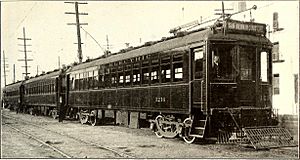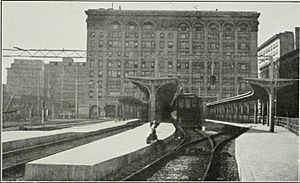Upland–San Bernardino Line facts for kids
Quick facts for kids Upland–San Bernardino |
|
|---|---|

A San Bernardino Line interurban train, 1916
|
|
| Overview | |
| Owner | Southern Pacific Railroad |
| Locale | Southern California |
| Termini | Pacific Electric Building San Bernardino, California minor terminals at Baldwin Park, Covina, and San Dimas |
| Service | |
| Type | Interurban |
| System | Pacific Electric |
| Operator(s) | Pacific Electric |
| History | |
| Opened | July 11, 1914 (full line) |
| Closed | March 28, 1947 (past Baldwin Park) October 15, 1950 (final) |
| Technical | |
| Line length | 57.78 mi (92.99 km) |
| Number of tracks | 1–4 |
| Track gauge | 1,435 mm (4 ft 8 1⁄2 in) standard gauge |
| Electrification | 600–1200 V DC overhead catenary |
The Upland–San Bernardino Line was a special type of train service called an interurban line. It was run by the Pacific Electric Railway company. This line connected Downtown Los Angeles all the way to San Bernardino, California. Some trains on this line also made shorter trips, ending in places like Baldwin Park, Covina, and San Dimas.
Even though the full service stopped in November 1941, this line was once the fourth-longest rapid transit line in American history. Only a few other lines, like the Sacramento Northern's Chico and Colusa services and Pacific Electric's own Riverside–Rialto Line, were longer.
Contents
History of the Line
Pacific Electric trains first reached Covina in 1907. They arrived in San Dimas on October 26, 1910. The part of the route between Pomona and Upland was built by another company, the Ontario and San Antonio Heights Railroad Company. Pacific Electric bought this company in 1912.
Trains started running from the Pacific Electric Building to Pomona on August 31, 1912. This was known as the Pomona Line. Finally, on July 11, 1914, the full service to San Bernardino began. This allowed passengers to connect with the San Bernardino Valley Traction Company. Pacific Electric spent a lot of money, about $1.4 million (which is like $41.6 million today), to bring this service to San Bernardino. A shortcut that went around Pomona was finished on November 4, 1914. A smaller train line, called a branch line, was built to Azusa in 1917.
Special Named Trains
In November 1920, two special trains with names started running on the line. The Citrus Belt Limited traveled east in the afternoon. The Angel City Limited made the return trip west in the afternoon. In 1930, two more named trains were added: the Orange Empire Limited and Metropolitan Limited.
Pacific Electric only ever had six named trains in its history. Five of those six trains ran on the San Bernardino Line! However, all these named trains were stopped in 1931. This happened because fewer people were riding the trains due to the Great Depression.
Changes and Closure
Through-service to Redlands stopped in 1936. The trains going to Pomona and San Bernardino started running separately in 1937. Before that, they often ran together and then split at Lordsburg. Most passenger service was cut back to Baldwin Park on November 1, 1941.
During rush hour, trains still went to Covina. They even used new tracks east of Baldwin Park that were bought in 1946. By 1947, all passenger trips ended at Baldwin Park. During World War II, special troop trains ran, but regular people could not ride them. On October 15, 1950, the service, then called the Baldwin Park Line, was completely stopped.
Even after it closed, the line was still popular with railfan groups. These groups enjoyed watching and riding trains. The very last passenger trip using electric power on the line happened on August 25, 1951.
What Happened Next
After the train line was closed, parts of its old path were used for the San Bernardino Freeway. Today, Metrolink trains use the same section in the middle of the freeway. This Metrolink service started in 1992. Between the cities of Claremont and Rialto, the old train path was turned into a walking and biking path. This path is called the Pacific Electric Trail.
The Train Route
The San Bernardino Line started at the 6th and Main Street station in Downtown Los Angeles. The trains left downtown on a raised structure above the streets. Then, they reached San Pedro Street at ground level. The tracks, which had two lines, ran along the city streets. They went north on San Pedro Street, then east on Aliso Street. They crossed the Los Angeles River and Mission Road on a bridge.
East of Mission Road, the tracks entered a private area. This path went east, then north, under the Brooklyn Avenue Bridge. It ran next to Ramona Boulevard (which is now part of the I-10 Freeway). The line continued north past the Macy Carhouse. At Enchandia Junction, another line, the South Pasadena Line, branched off. From there, the tracks went east, still next to Ramona Boulevard, through the State Street Yard to Valley Junction. Here, the Pasadena Short Line and Monrovia–Glendora Lines also branched off.
From Valley Junction, the two tracks continued east along Ramona Boulevard. They passed through City Terrace, Monterey Park, Alhambra, San Gabriel, and Rosemead. They reached Baldwin Avenue in El Monte.
From El Monte, the line continued east on its private path. It crossed the Rio Hondo river on a single-track steel bridge. The line then went back to two tracks and continued east. It was still on its private path next to Ramona Boulevard. It crossed Valley Boulevard and Peck Road to reach the east side of El Monte at the San Gabriel River. Again, the line became a single track to cross the river on a long wooden bridge. It returned to two tracks on the other side.
From the San Gabriel River, the line continued east on its private path, next to Ramona Boulevard. It went to Badillo Street in Baldwin Park. The two tracks continued along Badillo Street as far as Grand Avenue in Covina.
At Grand Avenue, the line became a single track. It ran on a private path along the north side of Badillo Street. At Banna Avenue in Covina, the line turned northeast. It ran on a private path (which is now partly covered by streets like Ruddock Street). At Stratford Lane and Lone Hill Avenue (San Dimas Junction), the main line turned east toward Pomona. A branch line continued northeast into San Dimas on a single track. The main line continued east from Lone Hill on its private path. It passed streets like Cataract Avenue and Walnut Avenue. It then turned southeast by Puddingstone Channel and ran next to Orange Street as far as E Street in Pomona. At E Street, a local Pomona branch line went south on a private path. This turn was made because local farmers helped fund the track to go further north.
The San Bernardino Line continued east on a single track on its private path. It ran north of Arrow Highway, next to the Santa Fe Railway. It passed Towne Avenue and Indian Hill Boulevard in Claremont. Then, it turned northeast and went to Benson Avenue in Upland. There, it turned east again to run between Arrow Highway and 9th Street. At 13th Avenue, it took a northeast course to Alta Lorna on a private path. It went as far as Grande Street and Archibald Avenue. From Alta Lorna, the line went east through open country north of Base-line Road. It passed Etiwanda Avenue and then turned southeast at East Etiwanda Creek into Fontana. It turned east again at Citrus Avenue in Fontana. It then ran north of Arrow Route Boulevard, next to it, through Rialto toward San Bernardino. The line entered San Bernardino on Rialto Avenue. It went east to a spot between "E" and "F" Streets. Here, the San Bernardino Line turned north to follow a private path to its end. This was at the shared Pacific Electric and Southern Pacific station on 3rd Street.
Main Stations Along the Line
Here are some of the important stations that were on the Upland–San Bernardino Line:

| Station | Major connections | City |
|---|---|---|
| San Bernardino | Arrowhead, Colton, Redlands, San Bernardino–Riverside Southern Pacific |
San Bernardino |
| Rialto | Riverside–Rialto | Rialto |
| Fontana | ||
| Etiwanda | Riverside–Rialto | Etiwanda |
| Upland | Riverside–Rialto | Upland |
| Upland–Euclid Ave. | Riverside–Rialto, Upland–Ontario | |
| Claremont | Pomona–Claremont, Riverside–Rialto, Upland–Ontario Santa Fe Railroad |
Claremont |
| North Pomona | ||
| La Verne | ||
| San Dimas (SP) | Pomona, Riverside–Rialto Southern Pacific |
San Dimas |
| Covina | Pomona, Riverside–Rialto | Covina |
| Baldwin Park | ||
| El Monte | Pomona, Riverside–Rialto | El Monte |
| Wilmar | ||
| Garfield Avenue | ||
| Covina Junction | Alhambra–San Gabriel, Monrovia–Glendora, Mount Lowe, Pasadena Short Line, Pasadena via Oak Knoll, Pomona, Riverside–Rialto, Sierra Madre | Los Angeles |
| Echandia Junction | Alhambra–San Gabriel, Annandale, Monrovia–Glendora, Mount Lowe, Pasadena Short Line, Pasadena via Oak Knoll, Pomona, Riverside–Rialto, Sierra Madre, South Pasadena Local | |
| Pacific Electric Building | Many lines including Long Beach, Santa Ana, Whittier | |
How the Trains Were Powered
This train line used a special way to get electricity that was different from other Pacific Electric routes. The overhead wires that powered the trains usually carried 1200 volts of direct current (DC) electricity. However, in towns and cities, the line shared tracks with local streetcars. In these areas, the power was reduced to 600 volts. The trains were designed to work with both voltages.
Special buildings called electrical substations provided this high-voltage power. They were located in places like Campbell Avenue, Baldwin Park, Baldy View, Etiwanda, and San Bernardino.
The Trains Used
By 1924, the Upland–San Bernardino Line was using a type of train called "1200 class rolling stock." These were the specific train cars that ran on this route.




